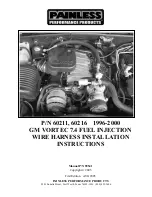
PRACTICAL INFORMATION
}}
103
Tires
Your vehicle is equipped with tires according to
the vehicle's tire information placard on the B-
pillar (the structural member at the side of the
vehicle, at the rear of the driver's door opening).
Some Volvo models are equipped with an
Ultra High Performance tire and wheel com-
bination designed to provide maximum dry
pavement performance with consideration for
hydroplaning resistance. They may be more
susceptible to road hazard damage and,
depending on driving conditions, may achieve
a tread life of less than 20,000 miles (30,000
km). Even if this vehicle is equipped with Vol-
vo’s advanced AWD or stability system, these
tires are not designed for winter driving, and
should be replaced with winter tires when
weather conditions dictate.
The tires have good road holding characteristics
and offer good handling on dry and wet surfaces.
It should be noted however that the tires have
been developed to give these features on snow/
ice-free surfaces.
Most models are equipped with "all-season" tires,
which provide a somewhat higher degree of road
holding on slippery surfaces than tires without
the "all-season" rating. However, for optimum
road holding on icy or snow-covered roads, we
recommend suitable winter tires on all four
wheels.
When replacing tires, be sure that the new tires
are the same size designation, type (radial) and
preferably from the same manufacturer, on all
four wheels. Otherwise there is a risk of altering
the car's roadholding and handling characteris-
tics.
Recommended tires
Your vehicle is factory-equipped with Volvo origi-
nal tires that are marked VOL
4
on the sidewall.
These tires have been carefully adapted to your
vehicle. When replacing tires, it is important that
the new ones also have the VOL designation in
order to help maintain the vehicle's driving and
handling characteristics.
New tires
Remember that tires are perishable goods. As of
2000, the manufacturing week and year (Depart-
ment of Transportation (DOT) stamp) will be indi-
cated with 4 digits (e.g., 0715 means that the tire
illustrated was manufactured during week 7 of
2015).
Tire age
Tires degrade over time, even when they are not
being used. It is recommended that tires gener-
ally be replaced after 6 years of normal service.
Heat caused by hot climates, frequent high load-
ing conditions or Ultra Violet (U.V.) exposure can
accelerate the aging process. The temporary
spare
5
should also be replaced at 6-year inter-
vals, even if it has never been used. A tire's age
can be determined by the DOT stamp on the
4
There may be certain exceptions depending on the tire's dimensions.
5
Not available in all models.
Содержание V90 2017
Страница 1: ...OWNER S MANUAL SUPPLEMENT ...
Страница 2: ......
Страница 7: ...5 INDEX Index 177 ...
Страница 8: ......
Страница 9: ...INTRODUCTION ...
Страница 50: ......
Страница 51: ...IMPORTANT INFORMATION ...
Страница 88: ......
Страница 89: ...PRACTICAL INFORMATION ...
Страница 149: ...FUSES ...
Страница 156: ... FUSES 154 ...
Страница 162: ......
Страница 163: ...SPECIFICATIONS ...
Страница 165: ...SPECIFICATIONS 163 Location of labels Generic illustration details may vary slightly depending on model market ...
Страница 167: ...SPECIFICATIONS 165 Dimensions The following table lists your vehicle s most important dimensions ...
Страница 174: ... SPECIFICATIONS 172 Related information Engine oil specifications and volume p 173 Coolant specifications p 170 ...
Страница 178: ......
Страница 183: ......
Страница 184: ...TP 23658 English USA Canada AT 1717 MY18 Copyright 2000 2017 Volvo Car Corporation ...
















































